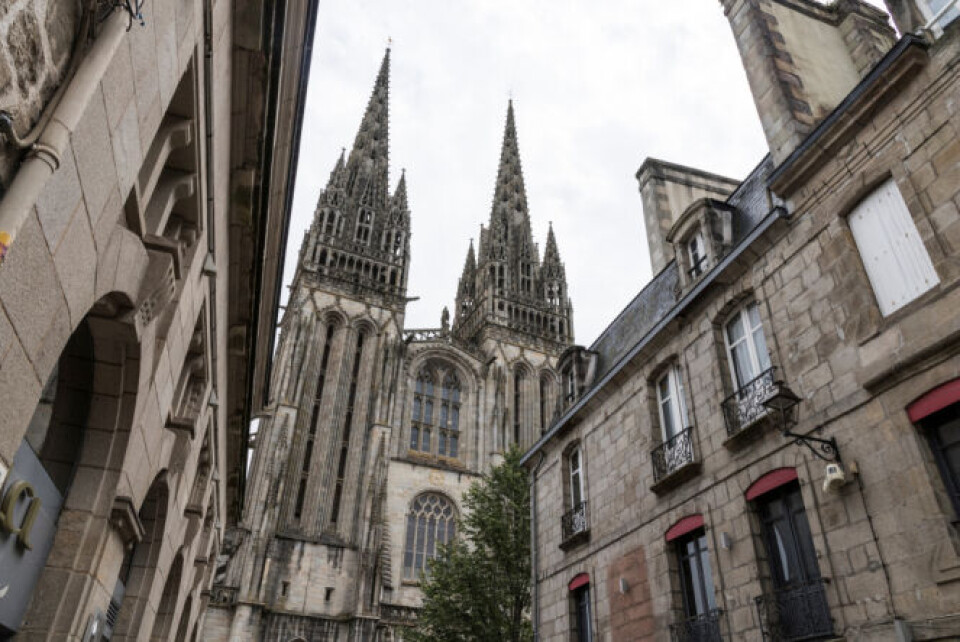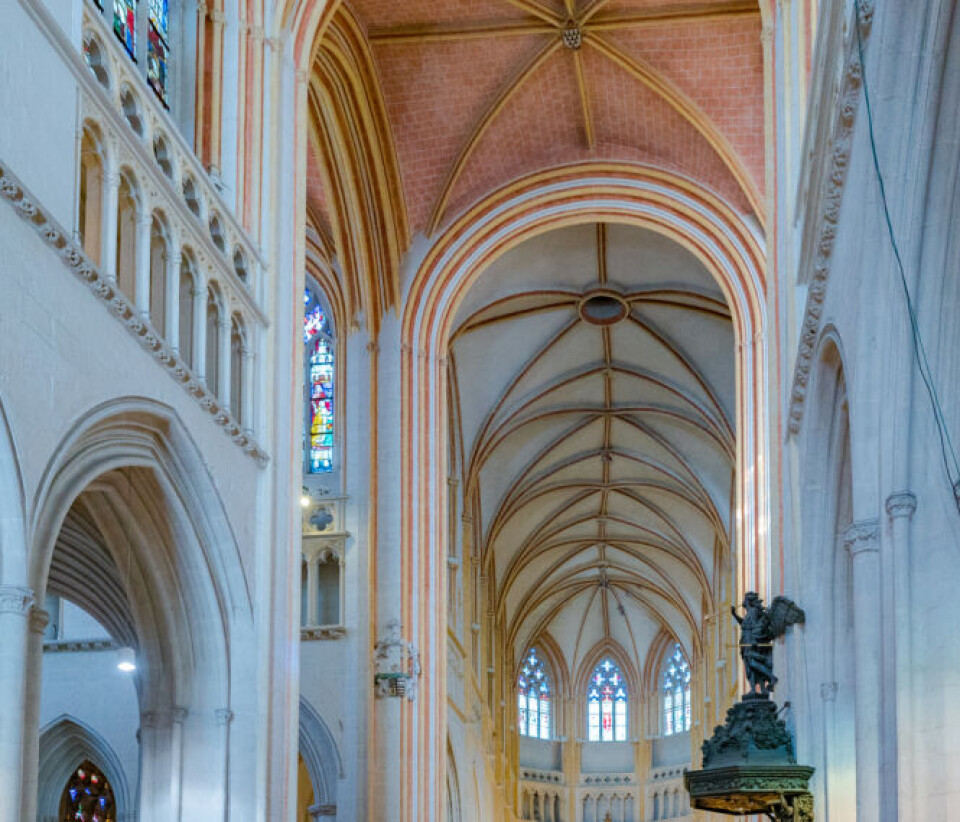-
Speed camera in Brittany reinstalled after being burnt three times
Mairie says radar is ‘only response to safety concerns’ by local residents
-
The five other capitals of France before Paris
Several other cities have held the honour for various reasons
-
Duck Cold! Four French phrases to use when it is freezing outside
We remind you of French expressions to use to describe the drop in temperature
Mysteriously skewed Brittany cathedral continues to confound experts
Archeological excavations suggest that the Cathedral of Saint Corentin was the third to be built on the site, leaving numerous riddles for archeologists to solve

A gothic cathedral continues to pose an architectural conundrum to experts, who cannot agree on its date of construction nor explain its famously skewed nave.
Quimper Cathedral in Brittany, officially known as the Cathedral of Saint Corentin, is one of the city’s oldest and most celebrated sights. It is ranked first among “13 unmissable sites” listed in the Quimper tourist office brochure and attracts huge numbers of visitors.
Archaeologists and historians told The Connexion that the nave, which bends eight degrees to the left rather than being straight, is the result of geological constraints.
Saint Corentin was built on the remnants of a smaller religious edifice, which meant construction of all the different features was not concurrent.
The nave was built after the High Gothic altar, at first leaving the choir from the earlier Romanesque period untouched.
“This was common practice during the Middle Ages,” said Yves Gallet, a historian at Bordeaux Montaigne University and a specialist on Gothic architecture.
He explained that keeping the original choir in place helped to maintain religious activities during the construction period.
This choir was eventually destroyed and replaced by a longer one.

Saint Corentin Cathedral in Quimper was built some time during the 13th century. Pic: Joaquin Ossorio Castillo / Shutterstock
Jean-Paul Le Bihan, a Quimper archaeologist and retired history teacher who directed the first archaeological excavations of the cathedral during the 1990s, said: “If the new choir was extended in a straight line, it would have been built on marshy ground.”
Mr Le Bihan said this forced workers to build at an angle to avoid the problem, a theory supported by Mr Gallet.
This explanation is only 30 years old and supersedes a theory that the bend was the result of efforts to build an underground gallery that would have seen boats floating below the cathedral.
Mr Gallet said this would have been impossible as the galleries would have collapsed under the weight. He dismissed the theory as a medieval myth.
Another popular explanation is that the nave is aligned with Christ’s head on the cross, which is turned to the left.
Although this was cast aside in the 19th century, Mr Gallet said some Quimper citizens are reluctant to let it drop.
During the excavation, Mr Le Bihan said he was often confronted by people who still believed it and he tried to provide scientific evidence to disprove them.
“The idea of a Christian ‘fantasy’ motive is more appealing. It is a little bit depressing at times,” he said.
Another bone of contention is the exact date of the cathedral’s construction.
“All my research points to a construction between 1280 and 1290,” said Mr Gallet.
He argues that the cathedral is typical of the High or Rayonnant Gothic style, which spanned the period 1230-1380.
He said this style would have been impossible in Quimper so early on as the genre developed in Paris before it reached Brittany. “When I proposed my theory, I received a cold reception, to say the least.
“I used to teach at nearby Brest University and studied the cathedral for many years, but it took Quimper’s tourist office 15 years before they would even consider my claim.”
The opposing theory that building started in 1239 was first put forward by historian René-François Le Men in his book Monographie de la cathédrale de Quimper, published in 1877.
It is supported by Mr Le Bihan, who says his 1990s excavation confirms this.
“The present cathedral is the third to have been built on this site,” he said. Although Le Men knew that, it was Mr Le Bihan who came up with more accurate dates for the earlier two buildings.
He found out that the first cathedral had a small choir and was constructed during the first millennium, while the second Romanesque-inspired cathedral was built between 1050 and 1150 and destroyed in 1239. It was replaced by the present-day Saint Corentin in 1245, and it was consecrated in 1287.
The vaults were constructed and decorated between 1408 and 1417, while the nave was finished in 1460. The transept and its decoration were built from 1467 to 1495. The spires came later – constructed between 1854 and 1856 –and the upper gallery of the nave was finished in 1860. Overall, the imposing cathedral measures 92.5m in length, including the 36m-long nave and an equally long transept. The spires are 35.4m high.

The skew-whiff nave and precise date of construction remain bones of contention. Pic: makasana photo / Shutterstock
Tours of the cathedral have been organised by the city since the 1990s and Yannig d’Hervé is one of the longest-serving guides, since 1999.
He tells the story of the cathedral and takes visitors around its corridors and walkways to point out the stained-glass windows and remind tourists that Saint Corentin is home to two buried bishops.
His tour also includes details of two restoration projects: the first during the 19th century and the second between 1988 and 2008.
Mr d’Hervé does not believe Mr Gallet’s theory on the alignment of the nave, casting doubts on the marshy ground claim when other buildings nearby are built on backfill soils.
“Some aspects feel impossible to me,” he said. “Was it a deliberate decision to build the nave at an angle? I do not think we will ever have the answer.”
Meanwhile, a less contentious cathedral development is due later this year: Philippe Mahé, prefect of Finistère, has promised an additional bell to bring the cathedral’s total to seven.
He hopes it will be installed in the belfry before December 12 to mark the feast day of the first bishop of the city, after whom the cathedral is named.
Related stories:
Why Strasbourg’s cathedral is one of France’s greatest treasures
1,000 years of travel: Meandering history of France’s Bayeux Tapestry
Beaulieu-sur-Dordogne: Why pilgrims flock to this French beauty spot
























